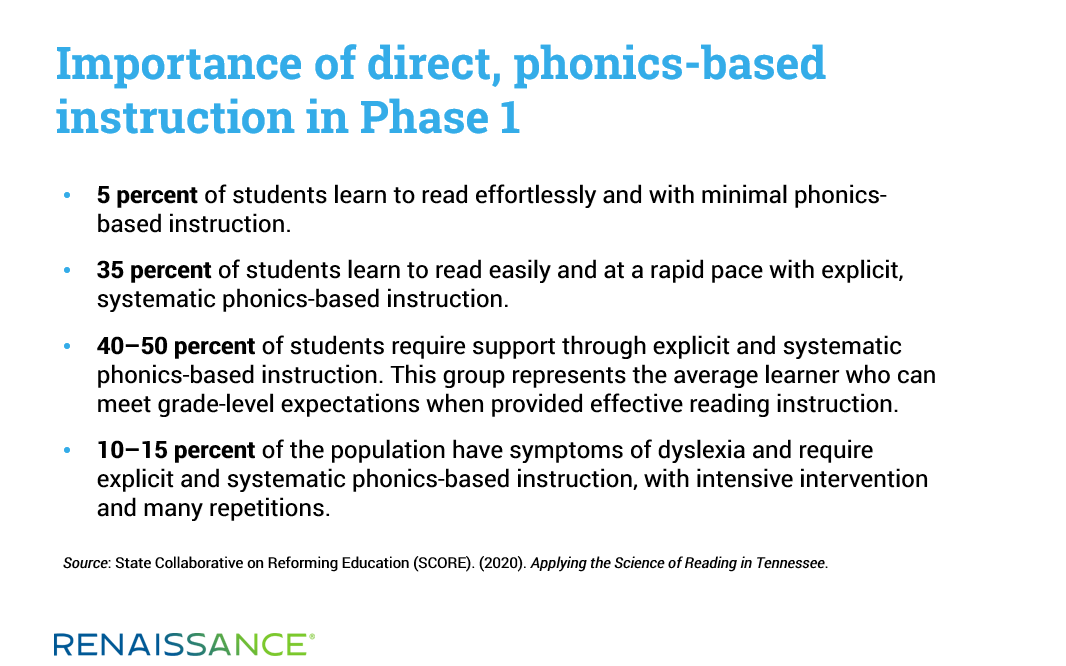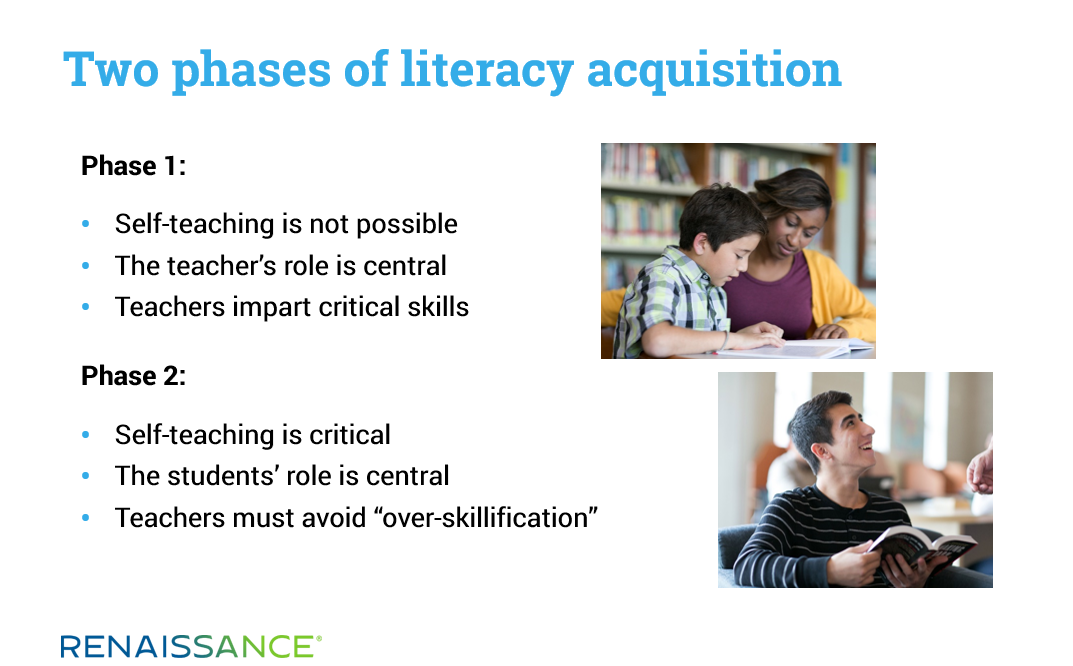March 26, 2021
In my role at Renaissance, I regularly present to teachers and administrators on student literacy. Recently, I’ve received many questions about the Science of Reading: what this term truly means, what we definitively know about effective reading instruction, and what questions are still to be answered.
A helpful definition is provided by Mark Seidenberg of the University of Wisconsin, who writes:
“The ‘Science of Reading’ is a body of basic research in developmental psychology, educational psychology, cognitive science, and cognitive neuroscience on reading, one of the most complex human behaviors, and its biological (neural, genetic) bases. This research has been conducted for decades in the US and around the world. The research has important implications for helping children to succeed.”
Generally speaking, I think the growing energy around the Science of Reading is a very good thing. We should ensure that reading instruction is informed by research to the greatest extent possible. However, there seems to be a bit of a wrinkle. Seidenberg’s definition above is immediately followed by his statement in bold that reads: “The science of reading is not just ‘phonics’.” With this statement, he is suggesting that some conversations about the Science of Reading may be limited. Even a quick review of documents and guidance on the subject reveals a narrative dominated almost exclusively by phonics and other foundational reading skills. But isn’t there more that we know from the Science of Reading that extends beyond the earliest grades and the most foundational of skills?
Let me be clear here. I firmly believe that serious attention must be focused on the early grades, given that critical foundations are built there. Phonics and other foundational reading skills must not only be taught explicitly but also systematically—which calls for far more coordination and precision than we have typically achieved.
I take this stance because I concur with Susan Pimentel (2018) that “phonics approaches have been consistently found to be effective in supporting younger readers to master the basics of reading…a school that doesn’t have a phonics program is doing its students a huge disservice.” Similarly, a research summary from Britain’s Education Endowment Foundation notes the research base for phonics as having “very extensive evidence,” its highest rating.
All of this is to say that I have no quarrel with the Science of Reading, but I do have a question. When will we focus equally, or even just a bit more, on the older kids? While the core concept of the Science of Reading is that all reading instruction must be guided by research, with no limitations as to grade level, the conversations I hear are only about the early grades. We need to realize that the Science of Reading also has important implications for middle and high school—implications that we have largely failed to understand or implement.
Why focusing on early literacy is not enough
In the early 2000s, the Reading First grants pumped billions of dollars of funding into grades K–3. However, there was no parallel grant program of any scale for literacy in grades 4 and above. There are also numerous state-level initiatives to ensure that students are reading on grade level by the end of grade 3. But as E.D. Hirsch (2006) pointed out, “It’s in the later grades, 6–12, that the reading scores really count because, after all, gains in the early grades are not very useful if, subsequently, those same students, when they get to middle school and then high school, and are about to become workers and citizens, are not able to read and learn.”
Clearly, the dominant share of our dialogue and our efforts is focused on the early grades. While this is appropriate—literacy cannot be built on shaky foundations—the steady stream of initiatives at the elementary level stands in stark contrast to the lack of dialogue, guidance, energy, and concern about literacy in grades 4 and above. It’s time we “showed some love” to literacy beyond the early grades.
The two phases of literacy acquisition
I believe that it’s not enough to point out a problem without also proposing a solution. In that spirit, I’d like to offer up a piece of guidance relevant to this dilemma—guidance that hinges on the connection between the Science of Reading and the importance of student self-teaching in middle and high school.
As I argued in an earlier blog, we’d be wise to envision literacy acquisition as involving two distinct phases. Phase 1 is about what we should do for students before they have learned the mechanics of reading. Phase 2 is about what we should do after they have learned this.
Phase 1 is all about the Science of Reading and ensuring that students receive explicit and systematic instruction around phonics and other foundational reading skills. Some students may struggle during this phase, and the more teachers understand how reading acquisition works, the more effective their interventions can be in supporting all students, including those who struggle. So, during this phase, the teacher’s role is very much about providing direct instruction on key, essential skills.

This stands in stark contrast to Phase 2. After students have learned the mechanics of reading, the focus should be less on what the teachers need to teach than on the conditions that teachers need to create so that students can accomplish the “self-teaching” they need for success (Share, 1995; Share, 1999).
Let me explain.
After they have learned the mechanics of reading, students—through wide exposure to text—build (or teach themselves) the ability to recognize more and more words instantly by sight. This is what cognitive scientists refer to as strong orthographic representations. At this point, reading comprehension increases substantially, because “adding orthographic representations results in a smaller attention demand for decoding, leaving more attention available for comprehending what you’re reading” (Willingham, 2017). This, in turn, facilitates students’ reading development: “Children make the transition from being ‘novices,’ reading words primarily via alphabetic decoding, to ‘experts,’ recognizing familiar written words rapidly and automatically, mapping their spellings directly to their meanings without recourse to decoding” (Castles et al., 2018).
In other words, when we encounter a word in print, we have two ways of taking it in:
- If it is a known word—one for which we have a strong orthographic representation—we take it in in a fraction of a second.
- If the word is not known to us, we must rely on our decoding and phonics skills, hoping to sound it out and find associated meaning.
A colleague once told me about the first time she encountered the word “façade” in print. She had heard this word before and knew its meaning, but she anticipated that it would begin with “ph-.” When she first saw f-a-ç-a-d-e, she had to slow down and sound it out. Already armed with some vocabulary knowledge of this word, when she sounded it out, associating meaning was instant. And with just a few more encounters, her orthographic representation for this word was built, and she recognized it instantly. This is how we become fluent readers capable of comprehension.
During wide reading, students also “self-teach” vocabulary at a rate that far exceeds what we can teach them directly. As Cervetti, Wright, and Hwang (2016) note, “It is not possible to directly instruct enough words to close the word knowledge gap.” They note that “learning words incidentally through reading and listening to text has the greatest potential to build” vocabulary. This is not to say that we should never teach vocabulary directly. Clearly, we should. But we should also realize the limitations of direct instruction and understand that if we do not create the conditions for students to read regularly, they will be unable to build the vocabulary base needed for future success.
As Stanovich and West (1989) state, “The single most effective pathway to fluent word reading is print experience: Children need to see as many words as possible, as frequently as possible” (cited in Castles et al., 2018). Mike Schmoker (2018) advises, “Once students learn to decode, they learn to read better and acquire large amounts of vocabulary and content knowledge by reading—not by enduring more skills instruction.”
But we should tread carefully here. We must realize how important the distinction between the two phases of literacy acquisition is, because the phases are so very different in terms of their dynamics:
- In Phase 1, before having learned the mechanics of reading, it’s not possible for students to self-teach. In Phase 2, self-teaching is critical.
- In Phase 1, the teacher’s role is central: she or he must impart key skills to students. In Phase 2, the teacher’s role becomes secondary, while the students’ role in self-teaching is at the center.
- In Phase 1, it’s about imparting critical skills. In Phase 2, it’s about avoiding the temptation of “over-skillification.” This means that the emphasis is placed so firmly on covering all of the standards and teaching all of the perceived reading “skills” that, at the end of the day, students have received many lessons and done many worksheets, but they have not actually read or written much at all.
Again, notice how different the two phases are. What is important in one is not all that important in the other. What is true in one may actually be false in the other.

The critical role of daily reading practice
Consider a quick example: guidance on the Science of Reading from one US state notes that “Children do not learn to read and write through exposure to print.” Yet it also calls for teachers to “ensure students read and are read to—a lot.” Here is where the two-phased approach sheds new light. Before they have learned the mechanics of reading, children do not learn to read and write through exposure to print. But after they have learned the mechanics of reading, much of their success is based on exposure to print—whether in hard-copy or digital format. This means that teachers must ensure that students read and are read to a lot, both in and out of school. So, what is false in one phase turns out to be true in the other.
Schmoker (2018) puts it this way: “Once students can effectively decode, we must organize time in language arts to ensure that students spend large amounts of time reading, both purposefully and for pleasure.” This is why programs that encourage and support daily reading—including the Accelerated Reader program and the myON digital reading platform from Renaissance—are so critical for students’ success. They help to create the conditions for self-teaching to occur.
Why literacy must be reframed in middle and high school
As my co-authors and I note in our new book Literacy Reframed, “becoming fully literate is analogous to taking a journey to a faraway land. Assume that getting there requires a flight and that the first step in getting to the airport requires exiting your driveway and turning right. Phonics instruction is that first right turn. That first turn is the correct, most efficient first step, but there’s much more to the journey.”
It’s time we balance the emphasis on a successful start to the journey with the critical importance of the entirety of the journey. Let’s make sure that our understanding and implementation of the Science of Reading is both broad and comprehensive enough to include the entire research base on what we’ve learned about reading—at all grade levels.
References
Castles, A., Rastle, K., & Nation, K. (2018). Ending the reading wars: Reading acquisition from novice to expert. Psychological Science in the Public Interest, 19(1), 5–51.
Cervetti, G., Wright, T., & Hwang, H. (2016). Conceptual coherence, comprehension, and vocabulary acquisition: A knowledge effect? Reading and Writing: An Interdisciplinary Journal, 29(4), 761–779.
Hirsch, E. D. (2006). Reading-comprehension skills? What are they really? Retrieved from: www.edweek.org/ew/articles/2006/04/26/33hirsch.h25.html
Pimentel, S. (2018). Why doesn’t every teacher know the research on reading instruction? Retrieved from: www.edweek.org/ew/articles/2018/10/29/why-doesnt-every-teacher-know-the-research.html
Seidenberg, M. (n.d.) Connecting the Science of Reading and educational practices. Retrieved from: https://seidenbergreading.net/science-of-reading/
Schmoker, M. (2018). Focus. 2nd ed. Alexandria, VA: ASCD.
Share, D. (1995). Phonological recoding and self-teaching: Sine qua non of reading acquisition. Cognition, 55(2), 151–218.
Share, D. (1999). Phonological recoding and orthographic learning: A direct test of the self-teaching
hypothesis. Journal of Experimental Child Psychology, 72(2), 95–129.
Stanovich, K., & West, R. (1989). Exposure to print and orthographic processing. Reading Research Quarterly, 24(4), 402–433.
State Collaborative on Reforming Education (SCORE). (2020). Applying the Science of Reading in Tennessee. Retrieved from: https://tnscore.org/wp-content/uploads/2020/01/Science-of-Reading-2020.pdf
Willingham, D. (2017). The reading mind. San Francisco: Jossey-Bass.
Looking for popular print and digital books for students in grades 4–12? Explore the latest edition of What Kids Are Reading, the world’s largest annual study of student reading habits. And if you’d like to learn more about using Accelerated Reader or myON in middle and high school, please contact us. We’re here to help.


